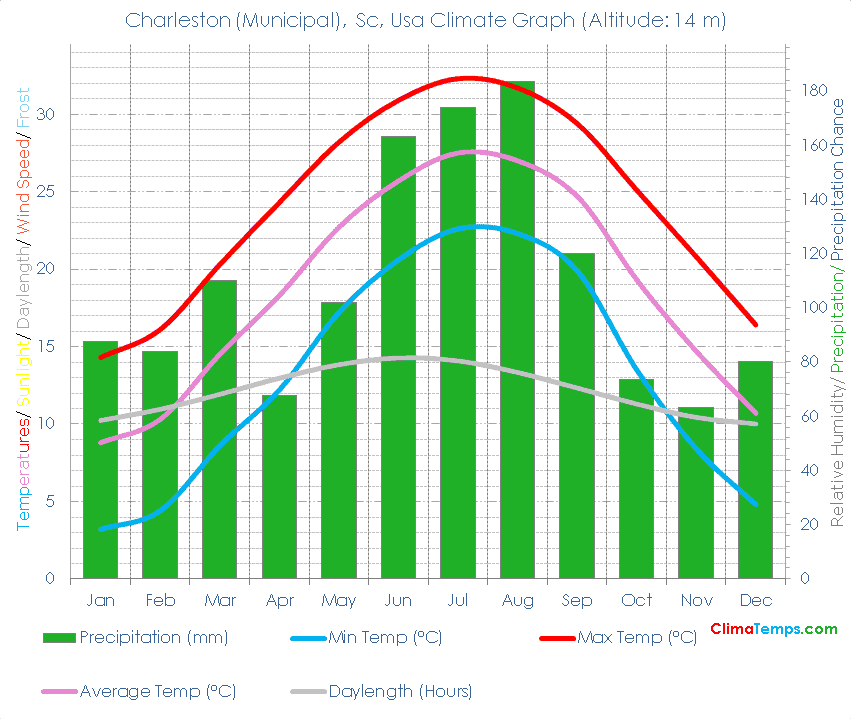Average Temperatures For Charleston SC: Your Ultimate Weather Guide
Charleston, South Carolina, is renowned for its charming cobblestone streets, historic landmarks, and picturesque coastal beauty. However, understanding the average temperatures for Charleston SC is essential if you're planning to visit or live in this vibrant city. Whether you're looking to enjoy its beaches or explore its cultural attractions, knowing the weather patterns will help you make the most of your time here.
Charleston enjoys a humid subtropical climate, characterized by hot and humid summers, mild winters, and distinct seasonal changes. This article will provide a comprehensive overview of Charleston's average temperatures throughout the year, ensuring you're well-prepared for any weather condition.
From historical data to expert insights, we'll delve into the nuances of Charleston's climate, offering practical tips for travelers and residents alike. Let's dive in and uncover what makes Charleston's weather so unique!
Read also:Grayson Russell Talladega Nights The Ultimate Fan Guide Youve Been Waiting For
Table of Contents
- Climate Overview of Charleston SC
- Seasonal Temperatures in Charleston SC
- Summer Temperatures
- Winter Temperatures
- Spring and Autumn Temperatures
- Historical Temperature Data
- Weather Patterns and Trends
- Travel Tips Based on Average Temperatures
- Impact of Climate Change on Charleston SC Temperatures
- Conclusion: Embrace Charleston's Weather
Climate Overview of Charleston SC
Charleston's climate is classified as humid subtropical, which means the city experiences warm and humid summers, mild winters, and significant rainfall throughout the year. The proximity to the Atlantic Ocean plays a crucial role in moderating temperatures, making the city slightly cooler in summer and warmer in winter compared to inland areas.
The average temperatures for Charleston SC range from 40°F (4°C) in the winter months to around 90°F (32°C) during the peak of summer. This variability makes Charleston an appealing destination year-round, but it also requires visitors and residents to plan accordingly.
Seasonal transitions are distinct, with spring and autumn offering pleasant weather that attracts outdoor enthusiasts. Understanding these patterns is key to enjoying Charleston's natural beauty and cultural offerings.
Seasonal Temperatures in Charleston SC
Summer Temperatures
Summers in Charleston are hot and humid, with average high temperatures often reaching 90°F (32°C) or higher. The heat is accompanied by high humidity levels, making it feel even warmer. Nights provide some relief, with temperatures typically dropping to around 70°F (21°C).
Here are some key points about Charleston's summer temperatures:
- June, July, and August are the hottest months.
- Thunderstorms are common during the afternoon, providing temporary relief from the heat.
- Beaches like Folly Beach and Sullivan's Island become popular destinations for cooling off.
Winter Temperatures
Winter in Charleston is relatively mild compared to many other parts of the United States. Average high temperatures during the winter months range from 55°F (13°C) to 65°F (18°C), while lows typically hover around 35°F (2°C) to 40°F (4°C).
Read also:Autumn Moon Night Market Seattle A Mustvisit Celebration Of Culture And Community
Important winter highlights include:
- December, January, and February are the coolest months, but frost is rare.
- The city experiences occasional cold snaps, but snow is extremely uncommon.
- Winter is an ideal time for exploring Charleston's historic district without the summer crowds.
Spring and Autumn Temperatures
Spring and autumn are transitional seasons in Charleston, offering mild and pleasant weather. Spring temperatures gradually warm up, with highs ranging from 65°F (18°C) to 80°F (27°C). Autumn sees a cooling trend, with highs between 70°F (21°C) and 85°F (29°C).
Key features of these seasons include:
- Spring is the perfect time for outdoor activities and festivals.
- Autumn provides a comfortable escape from the summer heat, making it ideal for sightseeing.
- Both seasons offer vibrant foliage and scenic beauty.
Historical Temperature Data
Historical temperature records for Charleston SC reveal consistent patterns over the years. According to the National Oceanic and Atmospheric Administration (NOAA), the city's average annual temperature is approximately 62°F (17°C). This figure has remained relatively stable, although slight variations occur due to natural climate cycles.
Data from the Charleston International Airport, one of the primary weather stations in the area, shows that the warmest month on record was July, with an average high of 92°F (33°C), while the coldest month was January, with an average low of 32°F (0°C).
These historical records are valuable for understanding long-term climate trends and planning activities based on seasonal expectations.
Weather Patterns and Trends
Charleston's weather patterns are influenced by its coastal location and proximity to the Atlantic Ocean. The ocean moderates temperature extremes, creating a more temperate climate compared to inland areas. However, the city is also susceptible to tropical storms and hurricanes during the Atlantic hurricane season, which runs from June to November.
Key weather trends include:
- Higher humidity levels during the summer months, contributing to the heat index.
- Increased precipitation in the fall, often associated with tropical systems.
- Mild winters with occasional cold snaps, but generally no extreme weather events.
Staying informed about these patterns helps residents and visitors prepare for any weather-related challenges.
Travel Tips Based on Average Temperatures
Whether you're planning a vacation or relocating to Charleston, understanding the average temperatures for Charleston SC can enhance your experience. Here are some practical tips for each season:
- Summer: Wear breathable clothing, stay hydrated, and take advantage of indoor attractions during the hottest parts of the day.
- Winter: Pack light layers, as temperatures can fluctuate. Enjoy outdoor activities on warmer days and explore indoor museums and galleries during cooler periods.
- Spring and Autumn: Dress in comfortable clothing suitable for moderate weather. Take part in local festivals and outdoor events during these pleasant seasons.
Additionally, consider checking the latest weather forecasts before your trip to ensure you're fully prepared for the conditions you'll encounter.
Impact of Climate Change on Charleston SC Temperatures
Like many coastal cities, Charleston SC is experiencing the effects of climate change, which can influence average temperatures and weather patterns. Rising global temperatures have contributed to warmer summers and milder winters in the region. Additionally, sea level rise poses a threat to low-lying areas, increasing the risk of flooding during heavy rainfall events.
Efforts to address these challenges include sustainable urban planning, improved flood management systems, and community education initiatives. By staying informed and supporting these efforts, residents and visitors can help protect Charleston's unique environment for future generations.
Conclusion: Embrace Charleston's Weather
Understanding the average temperatures for Charleston SC is essential for anyone looking to experience the best this vibrant city has to offer. From the sultry heat of summer to the mild comfort of winter, Charleston's climate provides a backdrop for year-round enjoyment.
We encourage you to share your thoughts and experiences in the comments section below. Have you visited Charleston during a particular season? What was your favorite activity? Don't forget to explore our other articles for more insights into Charleston's culture, history, and attractions.
Stay connected and enjoy the beauty of Charleston, no matter the weather!



